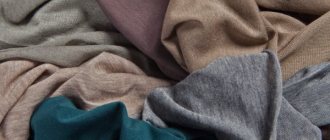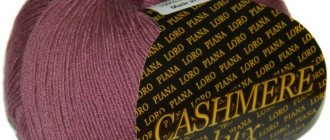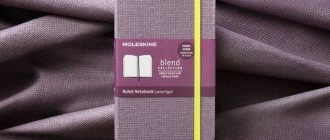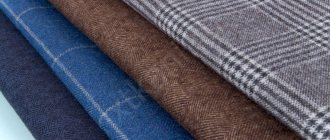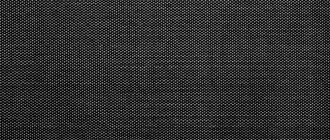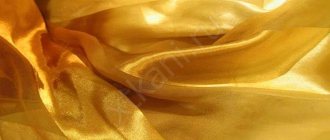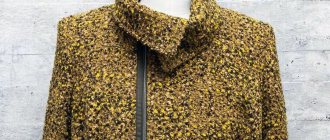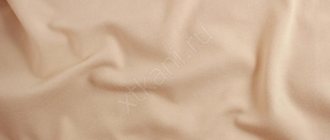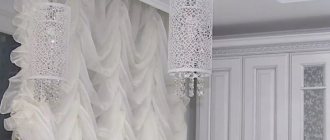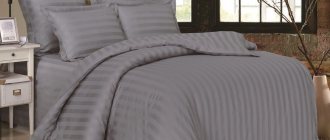Cashmere fabric is considered royal wool due to its rarity and unique properties: the material is especially thin and delicate, while being warm and cozy even in appearance.
Hypoallergenic luxury wool is used to sew basic wardrobes, underwear and children's clothing. We explain in detail in the article: what kind of material cashmere is and what you need to know about it.
Pink Mongolian Cashmere
What is cashmere and how is it made?
Cashmere fabric, also known as pashmina, is an expensive material made from the undercoat of mountain goats. It is particularly soft and tender, remaining warm, like other types of wool.
The material is produced strictly by hand, since the thin, delicate fibers are extremely valuable and require careful handling. Goats are combed once a year - in the spring, extracting about 200 grams of light fluff from one animal.
After this, the wool is processed, which reduces the volume of the material by half, and the output is a thin yarn, from which cashmere is made. It is the subtlety and labor intensity of the process, as well as the rarity of the raw materials, that elevate the fabric to the rank of one of the most expensive in the world.
Mountain Kashmir goat
Properties of cashmere
Cashmere has several incompatible properties:
- Cashmere weighs a couple of grams. It is so airy and light that a scarf made from this material can be pulled through a standard size ring;
- In terms of softness, cashmere fabric is many times superior to silk, since the fibers of the former are thinner than those of the latter;
- Cashmere is considered one of the warmest materials; its fibers have low thermal conductivity;
- Cashmere is not a breeding ground for dust mites, so this wool cannot be an allergen;
- Wear-resistant and durable like wool and silk fabric;
- Other materials are less susceptible to the formation of pellets.
It is also known that in addition to these properties, cashmere has healing properties (by retaining heat, it reduces the intensity of pain), and the wax contained in the fibers has a good effect on the skin.
Origin and history
The characteristics of the pile used to make natural cashmere are determined by the specific climate of the Himalayan mountains. Goats that provide valuable undercoat are bred only in India, Pakistan, Mongolia, China and Nepal. The name of the fabric comes from the province of the same name - Kashmir - located on the border of India and Pakistan.
Cashmere products have a fluffy “halo”
Residents of the Himalayan regions noticed the valuable properties of mountain wool back in the 16th century, realizing that thin and light things that can be created from goat hair provide excellent warmth even at very low temperatures.
Later, European colonialists learned what cashmere was, its composition (what the fabric was made of) and brought expensive products to the Old World, where cashmere immediately took its place on the shoulders of aristocratic people.
Delicate bedspread
HOW TO DISTINGUISH REAL CASHMERE FROM SYNTHETICS VISUALLY?
This method is universal; it is also useful when purchasing a scarf through an online cashmere store. Carefully examine the fiber structure of the product - in the online display case this is done by enlarging the image.
Natural cashmere always contains fine down fibers. They are 4-6 times thinner than a human hair. The weightless wool seems to envelop the scarf with a haze and form branches over its entire surface.
Synthetic fibers are dense and of uniform thickness. In finished products they look like a solid, smooth canvas.
Properties and features of cashmere fabric
Cashmere is the thinnest woolen fabric in the world; it is often used to make not only thick scarves, but also flowing stoles. Such a product can easily be passed through the gap of the ring. The material also has other distinctive qualities:
- Ease. Even cashmere coats are not burdened by ladies' and children's hangers.
- Strength and wear resistance. Cashmere lasts a long time without losing its shape and valuable properties.
- Thermal protection. The fabric warms well, holding a small air cushion, and also pleasantly massages the skin.
- Beautiful matte surface and smooth texture. Cashmere is distinguished by its elasticity, density, neat and elegant appearance. Due to this, it is often used for sewing elegant warm clothes.
- Flexibility. Thin products pleasantly fit the silhouette without creating rigid folds or creases or causing discomfort. Items made from pashmina do not wrinkle and, with careful care, do not stretch.
Note! A special feature of natural cashmere is its healing effect. According to research, the fabric has a positive effect on the joints and vascular system not only due to micro-massage of the skin, but also due to the goat wax contained in the hairs.
You might be interested in the components of stripe satin: areas of application of the fabric
It is advisable to protect the fabric from pungent odors, aggressive chemicals and moths.
Does cashmere pill?
Natural cashmere is characterized by increased strength and smoothness, and the structure of the delicate pile is such that the products do not break in. Synthetic things have this tendency, so if the product contains artificial additives, it may well become covered with small nodules over time. By whether the purchased cashmere pills, you can determine whether the item is truly made of elite material.
Snow white cashmere coat
Manufacturing secrets
Cashmere has a long history. Ancient craftsmen collected knowledge about the material bit by bit and passed it on to future generations. To transform raw materials into valuable things, special technologies are needed. Italians speak them better than others. They know how to clean yarn, weave it into the finest fibers and make warm, airy garments from them. High-quality cashmere fabric is also produced by Scottish craftsmen who master the technique of working with woolen fabrics.
Our contemporaries can only enjoy the healing cashmere, its unique properties and impeccable beauty.
Varieties
A beautiful word associated with luxury can mean several types of fabric:
Coat fabric
Cashmere is used to make outerwear, supplemented with other types of wool, such as alpaca. The finished products consist of only a third of the down component, but thanks to this they become very soft and warm. Additional fibers help protect the fabric from getting wet.
Eco-cashmere
Under the deceptive name with the “clean” prefix, there is a synthetic fabric that looks exactly like natural cashmere. Along with the advantages - reduced value and pleasant appearance - it also has several disadvantages: it heats less and stretches over time, changing the shape of the product.
Note! Less commonly, this name can be understood as 100% products made from unpainted natural material, presented in the premium segment.
The range of cashmere products can satisfy a wide variety of needs
Mongolian
Mongolian is the name given to hand-made cashmere from the provinces of China and Mongolia. The raw materials are processed with special care, and the end result is durable and especially durable items that do not lose their shape even after many washes.
Are pashmina and cashmere the same thing?
As a rule, pashmina is the raw material from which the fabric is made, and cashmere is a ready-made luxurious material. But these words can be considered synonyms and can be understood as both the undercoat of Himalayan goats and all products made from delicate fabric collectively.
The Europeans began to call the fabric cashmere, since it became legendary and recognizable, and its peculiarity was the place where rare wool was mined. The raw material was called pashmina in its homeland, so both names stuck on people’s lips.
Melange checkered color
Types, features, use of cashmere
Cashmere fabric is one of the most expensive, but at the same time popular all over the world. It is of natural origin, created by twill weaving from the fluff and undercoat of cashmere Indian goats. At a high cost, this fabric has not only a number of important characteristics (warmth, softness, thinness, wear resistance) but also an incredibly beautiful, presentable appearance.
Using Cashmere Fabric
Cashmere fabric has been used since ancient times to create clothing and bedding. It is very warm, but thin and soft, so warm cashmere items can be stored compactly. And for the indigenous peoples who invented cashmere, this was very important.
Modern clothing designers use cashmere to create literally everything for women's, men's and children's wardrobes. These are dresses, suits, sweaters, turtlenecks, scarves, hats and capes. Cashmere is used to make demi-season jackets, ponchos, etc. Cashmere blankets, blankets, and sets of warm blankets for children are also known all over the world for their warmth (and high cost, of course).
Cashmere fabric can be used to create socks and other underwear items. Such things are used mainly by tourists who love winter travel. Cashmere is also chosen for children born in winter. This fabric can be used to sew baby envelopes and make upholstery in the cradle of a stroller so that the child does not freeze.
Features of cashmere
The main feature of cashmere fabric is its ability to retain heat and the fineness of its workmanship. This is due to the extraordinary thinness of the cashmere thread, which is almost 3 times smaller in cross-section than a human hair.
The high cost of cashmere is due to the fact that only 150 grams of material can be removed from one purebred goat at a time. And for an average product you will need up to 2 kilograms. This is why the fabric is so expensive.
Cashmere sheep are grown only in India and Mongolia; attempts to breed them in Zealand and Scotland failed because the climate was not suitable for such delicate wool.
One of the features of cashmere fabric is the need for careful care. Here are some simple rules that will make your cashmere items beautiful and preserve their quality for a long time:
- Cashmere cannot be washed with a spin cycle. It is better to wash things by hand or take them to dry cleaning.
- Cashmere items should not be wrung out. They are dried on the table, for example, without stretching.
- Cashmere items can only be ironed with steam and not with a contact iron.
- Items made from cashmere thread should be stored on special hangers, preferably in covers. Experts advise to beware of moths, so you can use lavender or cedarwood essential oils in those closets where cashmere items are stored.
Types of cashmere fabrics
There are several types of cashmere fabric, depending on the type of dressing and the material itself:
- Mongolian cashmere. It is quite dense, but thin. Mongolian cashmere is made by hand by mixing wool from several goat breeds. This fabric does not become covered with “pellets” and does not stretch.
- Coat cashmere. For strength and density, the cashmere in this fabric is mixed with the wool of other animals, such as alpaca thread. This fabric is very dense, but at the same time soft and warm. It is resistant to moisture and active wear.
- Eco-cashmere. This is a synthetic material, without cashmere goat hair. It bears this name due to its softness. But eco-cashmere is not nearly as beautiful and warm as real cashmere.
- Double-sided coat cashmere. The fabric can be smooth and plain on both sides, or it can be of different colors and patterns.
You can buy cashmere fabric in almost any store. It makes wonderful items for everyday wear and a dressy wardrobe.
textilemarket.ru
Application of material
Although the most famous cashmere products that have conquered the world are light coats and bright stoles, painted in oriental style, many more varieties of things are made from the rare material:
- bedspreads;
- scarves and shawls;
- socks and winter underwear;
- gloves, accessories and outerwear;
- sweaters, turtlenecks, vests and blouses;
- skirts, trousers and suits;
- children's clothing;
- dresses and many other products.
Note! Fine wool allows you to create delicate and sophisticated items that fit the figure and do not create any discomfort for the wearer.
Thanks to such unique properties, cashmere conquered the whole of Europe back in the middle of the last millennium; luxurious clothes and bedding were made from it.
Camel scarf
How to distinguish real cashmere from a synthetic fake
Often, under the guise of natural cashmere, they offer products obtained in a similar way, but created from more affordable types of pile. The quality of such items may not be inferior to the original, so for many who want to show off a luxurious product made from valuable material, buying a substitute becomes a profitable option.
You might be interested in what you can sew from kulirka: composition and features of the fabric
You can’t always trust the description of the fabric composition on products, so you can determine whether the base is made from natural cashmere by the following signs:
- There is always a slight fluff on the surface of real cashmere wool, but synthetics will be much smoother.
- Artificial fibers have a characteristic creaking quality, which does not happen with wool.
- Real fabric is not electrified, which can be checked by rubbing it on a plastic surface and applying the item to your hair.
- When you pick up an item made from natural cashmere, you can feel a surge of warmth within just a few seconds, while synthetic fabric creates a warming effect for much longer.
- Pashmina has a pleasant matte color, while man-made fibers usually give a slight shine and shimmer in the light.
- A radical way to test is by fire. Synthetics quickly begin to melt even from an approaching flame, and also emit a plastic smell.
Note! When it comes to fibres, man-made cashmere tends to be more resilient than bouncy natural items. But knitted items may spring back due to the characteristics of the weave, not the threads themselves.
Headbands
Why is cashmere so faded?
Completely natural cashmere is not treated with any dyes, so its palette matches the color of mountain goats - from snow-white to brown-black shades. In order not to spoil valuable raw materials and preserve the beneficial properties of the fabric, the products are sold for sale in their natural form.
Description of the material “Artificial cashmere”
Durable, beautiful and inexpensive artificial cashmere is in increasing demand. In terms of its properties, modern fabric is not much inferior to its natural counterpart, but it is much cheaper and more unpretentious.
Faux cashmere is soft and beautiful. The texture is uniform and smooth, the canvas is even and of the same density. A nice plus is the ability to dye it in the brightest colors, unlike natural wool.
Synthetic cashmere is stronger and more durable. Depending on the presence of additives, it can be shiny or completely matte. Clothes made from it are comfortable to wear and perfect for every day.
How to care for artificial cashmere?
Having found out what kind of fabric artificial cashmere is, it’s time to pay attention to the features of its use and care. General recommendations are the same as for other delicate synthetic items. The thinner and more elegant the fabric, the more carefully it needs to be handled.
Figuring out how to wash faux cashmere is not difficult. The specifics of care depend on the structure of the material. Therefore, first you need to decide whether artificial cashmere can be washed at all.
Most often, the base is viscose fibers, which do not require specific conditions. A delicate regime, gentle detergents and a temperature of up to 40 degrees are enough. Do not rub or twist the fabric intensively, so as not to spoil its structure and to avoid pilling.
It is better to dry and store cashmere clothes on hangers. The fabric drapes and flows well, so when folded, creases may appear that are difficult to get rid of. But if stored properly, clothes will always be neat and neat.
Faux cashmere is great for jackets and dresses. It looks elegant and expensive, fits beautifully and gives long-awaited comfort.
If you take care of how to care for new items made from artificial cashmere in advance, they will last many times longer. And throughout the entire period they will delight you with their beauty and impeccable quality.
grandstock.ru
Features of caring for cashmere products
In order for expensive fabric to retain its valuable properties for a long time and remain neat and pleasant to the body, it is necessary to ensure proper care of cashmere items:
- wash fabric only in cool water;
- do not use rough spin, including when washing by machine;
- use gel detergents, avoiding abrasives;
- dry the washed items by carefully laying them out on a cotton cloth or mesh, do not hang them by the shoulders or other edges;
- do not wear things so that they do not absorb body and environmental odors;
- If ironing is necessary, use steam devices without heating the product with an iron.
Note! Cashmere should be protected from moths by choosing cedar cabinets and using scented backings such as lavender.
Three-color stole
How to wash, clean and iron a coat?
If you clean your cashmere coat at home, you need to carefully study the composition of the product. 100% cashmere is washed only by hand at a temperature of no more than 30°C without using rough brushes and without twisting the fabric so that the coat does not lose its shape. You can use a sponge and a mild wool cleaner.
Materials with synthetic impurities can also be washed in a machine, choosing the most delicate mode without spinning. After washing, the coat is blotted with a clean towel and laid out to dry on the crossbars of a folding unit, on a table on top of the fabric, or on thick hangers so that the sleeves do not sag.
Men's scarves
You can smooth out a coat using steaming, but it is better not to carry out such procedures at home, entrusting an expensive item to professionals.
How to care for pellets
Although natural cashmere items do not produce pilling, similar items may develop lint knots over time. To remove them accurately, it is best to purchase a special device - a roller with a safe blade, which will remove all unwanted “relief” from the surface.
Such tools are usually sold in boutiques that sell cashmere, and are sometimes included as gifts with purchases. You can also buy a roller at hardware and sewing stores.
You may be interested in: Appearance of flax: use of fibers
Bobbin with yarn
Cashmere: description, types, composition, photos and new items 2021
Cashmere is a natural fabric and has a very fine and soft structure. The material is woven from threads for which wool is used, only secondary hairs, cashmere mountain goats.
Visually, the fibers of the undercoat resemble fluff, which is why cashmere products are known for their lightness and warming quality.
History of the origin and popularization of fabric
The name “cashmere” has a territorial meaning, as the region of Kashmir, located in the north-west of the Hindustan Peninsula, was called. Today, the former princely state in the Himalayas lies on the border of India and Pakistan. It was there that the production of fabric began.
Several centuries ago, residents of mountain peaks not only began to cut animals as before, but also paid attention to the structure of the undercoat. Which was very thin and located very tightly around the primary hair - wool.
The main purpose of the undercoat is thermal insulation.
The fluff of cashmere goats was highly valued, so many countries tried to breed the animals themselves, but the attempts were not successful. Due to unsuitable climatic conditions, the undercoat lost its unique qualities.
That is why today, as in other times, suppliers of first-class cashmere yarn are India, Mongolia and China.
Video: What is cashmere?
Cashmere production
The production of down is entirely done by hand. The undercoat is plucked or combed during the moulting period of mountain goats. This happens once a year - in the spring, it is during this period that mammals undergo a seasonal change of coat.
One goat per year can produce from 150 to 200 grams of unrefined (primary) cashmere. After processing and cleaning the fluff, much less of it remains, 80-120 grams, which accounts for more than 50% of production losses. After which the process of sorting fibers by thickness begins.
Spinning is the process of obtaining yarn from fluff, also done by hand. After which the threads can be dyed.
This is why genuine cashmere is an expensive and rare material.
There are two categories of cashmere yarn:
- pashmina - the most delicate fluff, with a cross-section of no more than 15 microns (micrometers);
- semi-pashmina (cashmere) - undercoat hairs more than 15-19 microns thick.
After all the preparatory procedures, the woolen threads are sent to weaving factories, where cashmere fabrics with twill weave or knitted weave are woven.
Often, manufacturers of cashmere fabrics, in order to reduce the cost of the material, include Angora rabbit fluff, the undercoat of other goats, or even a synthetic analogue, which change the original properties of the material.
Real cashmere fabrics are not brightly colored. For the most part, the canvases are white, gray, brown or black. Even after dyeing the white fluff, the fabric retains its characteristic “smoky” tint.
Kinds
Cashmere fabric is currently offered by different manufacturers in several versions. This is due to the way the threads are made.
Mongolian
The down of Chinese and Mongolian goats is used to produce the material. Linted fibers undergo careful manual processing. The result is a first-class material, products made from it are very soft, and no pills form on the surface.
Coat fabric
The most common type of cashmere. It consists of 30% wool from cashmere goats, the remaining 70% is the wool of other animals, most often alpaca.
Coat cashmere has a homogeneous structure, it does not wrinkle and does not pill. The fabric is pleasant to the touch, smooth and soft.
For the production of expensive coats, double-sided fabric is used. Its peculiarity is that two sides are front, so there is no need to use a lining.
Eco-cashmere
This version of matter is the least expensive and therefore is publicly available. The composition does not include animal underfur; it is made from polyester and viscose (80/20%) imitating cashmere fabrics. Therefore, its thermal conductivity and aesthetic qualities are less pronounced than those of “real cashmere”.
Exquisite properties
Cashmere thread is three times thinner than human hair, but not only these characteristics of royal textiles explain its advantages:
- airiness - a shawl made of high-quality cashmere, can be easily threaded into a wedding ring;
- lightness and softness - fluffy fabric has little weight, which makes wearing the products comfortable;
- warming properties – low thermal conductivity;
- hypoallergenic – natural composition, does not cause rash, irritation or itching upon contact with the skin;
- The fabric is durable and wear-resistant.
The fabric has significant positive reviews from consumers who note the healing properties of cashmere products.
Scope of application
Amazing linted fabric is versatile. It is used to produce textiles for newborns (possibly used in the interior of a baby’s room), clothing for children and adults. It is suitable for sewing many products:
- hats, berets;
- shoulder products, shawls;
- coat;
- jackets and cardigans;
- gloves and mittens;
- socks, leggings, knee socks;
- Skirts and sweaters are made from knitted cashmere;
- from suit - trousers.
Warm cashmere sweaters and dresses are especially popular; they can often be found in the winter collections of famous brands and fashion houses in Italy and Scotland.
Handmade shawls and carpets, bedspreads and rugs from eastern countries are still famous.
The material is so good that interior designers use it for home decor too. Curtains and curtains of “Lux” quality are sewn from it. Although some manufacturers, to reduce the cost, produce imitations that are visually similar to natural fabric.
How to care for cashmere products
Real cashmere down is durable, but still requires careful handling and compliance with the rules of delicate care, even if the product contains other fibers. To preserve the original qualities, follow several rules:
- do not wear the product every day, give it a “rest” for a couple of days between wears;
- Store delicate knitted items and shawls folded, and store thicker items on hangers.
Do not rush to wash the sweater after the first wear; in order to maintain the good condition of the product, you can wear it 8-10 times between washes.
Recommendations for washing, drying and ironing:
- Cashmere can be washed either by hand or by machine in a delicate cycle;
- the water temperature should not exceed 30 °C;
- When washing, use a gentle detergent;
- you cannot wring out, let alone twist, cashmere products;
- “gently” remove excess water by placing it on a water-absorbent cloth;
- dry flat, without creases, on a white cloth or towel;
- avoid exposure to direct sunlight;
- do not dry on heating devices;
- The fabric does not require ironing, but can be steamed if necessary.
Customer Reviews
Irina: “I love wearing cashmere sweaters in cold winter.
They keep you warm and are incredibly light and comfortable. I feel very comfortable in them." Anna: “I bought myself a coat from Eco-cashmere from a famous brand. Finances did not allow purchasing from natural undercoat. But I'm still happy with it. The material looks high quality and does not require maintenance. I wear it until late autumn and don’t freeze.” homeinterior.pro
Why do prices for cashmere items differ by 5-10 times?
Natural cashmere items may vary in price. The cost of the product depends on the purity of the material and often on its color. If the label says cashmere, find out what kind of material it is and what impurities it contains.
100% pashmina is an undyed fabric of natural shades: white, milky, grayish, black. Sometimes products are dyed, and sometimes colored wool or silk is added to cashmere, which reduces the cost of the item. Bright models are more accessible, while 100% ones are much more expensive and are considered elite.
Synthetic fabrics will differ in price, so when you come across an inexpensive product, you need to think about what it is - eco-cashmere or wool. You can buy such a thing, but it will not have a complete list of the properties of pashmina.
Women's dress
Price per meter
What is the price? The cost of cashmere per 1 m is 2000-3000 rubles. The cost of material is influenced by factors such as thickness and shade. If you choose natural material, it has black, gray, white and brown colors. The most expensive is white fluff, because it lends itself best to dyeing and is much more delicate.
The link describes the properties of spandex fabric.
Types of calico are described here.
Find out how to choose the best crib mattress: .
Advantages and disadvantages
Having learned what cashmere is, it is easy to draw conclusions about its advantages over other types of wool:
- warm things can be thin, delicate and sophisticated;
- the fabric does not cause irritation like sheep's wool;
- goat hair does not harbor mites, so cashmere is hypoallergenic;
- Cashmere is universal and is even used in the production of children's underwear;
- the material holds its shape for a long time during wear, does not roll down and does not become electrified;
- If necessary, the raw material can be mixed with other convenient fibers.
Winter tights
But even “royal wool” has its flaws:
- difficult to care for, it needs frequent washing;
- light-colored items are very easily soiled;
- the price of products made from natural goat down is approaching the premium level.
Note! In addition, descriptions of the composition of the fabric allow even products with a high proportion of synthetic fibers to be called cashmere. Therefore, before purchasing supplemented cashmere, find out what it is and what fibers are added to the composition. As a rule, expensive material is not mixed with low-grade synthetics.
HOW TO DISTINGUISH REAL CASHMERE FROM SYNTHETICS BY COLOR?
Remember the main rule. Natural cashmere never shines, it is matte and hazy. If there is shine, it means silk or synthetic fibers have been added to the yarn. Practice shows that manufacturers indicate the percentage of silk on the label. But, unfortunately, they are silent about the addition of synthetics.
The combination of cashmere and silk is quite successful and is often practiced by many manufacturers. Silk is much cheaper than cashmere, but it adds strength to the accessory.
There is one more nuance - the brightness of the color. Indian artisans dye the undercoat of mountain goats by hand and use plant juice and other natural additives for this. It is impossible to achieve rich color with natural dyeing. Therefore, high quality cashmere down has muted smoky shades.
Reviews
Julia: “Once I saw a thin and very soft sweater, stylish and so impressive, youthful. I was surprised what kind of fabric it was - cashmere. It was very expensive, but it resonated with me so much that I bought it. And now he is 8 years old, and he still pleases - warm and sophisticated, feminine, completely erasing the idea that a sweater should be bulky.”
Oksana: “Once they recommended cashmere gloves for the winter for comfort. They explained that they do not hide flexibility, are pleasant to the touch and warmer than all others. Having sensitive skin prone to allergies, I was afraid and asked: cashmere - whose wool is it? It turns out that it is a goat, which is practically harmless. So I bought beautiful gloves, and I’m still happy.”
Pleasant to the touch material
Anna Georgievna: “The most favorite things come to us unexpectedly. Once the family gathered for the theater, and I realized that it was not good to go in a puffy jacket. We bought a coat made of Turkish cashmere. What a thing this is! It is thin, but very warm, I wear it even in cold weather, even its appearance warms my soul. Fits perfectly and has not lost its shape over the years even after cleaning.” Having learned better about cashmere and what it is, the desire to purchase a cozy item made from this pleasant fabric only increases. They say that luxury items in your wardrobe bring good luck - perhaps a cashmere item will fill your life with new colors.
Types of fabric
Natural cashmere fabric is divided into the following types according to density:
- knitwear is the thinnest;
- dress - somewhat tighter, used to create summer dresses;
- suit - compacted version;
- coat
Warm coat fabric with a fleecy surface is pleasant to the touch, but has a more rigid structure. They are chosen for sewing coats, warm jackets, and skirts. The most popular color is grey.
Another type of fabric for tailoring is Virginia cashmere. Made from the wool of lambs up to one year old. It is characterized by softness, lightness, and high heat-retaining properties.
Carded
The automated process of combing the fluff and further processing it in a carding machine significantly speeds up the time it takes to obtain fabric, but the fibers are thicker and coarser.
To view an overview of some types of fabric:
Modal
One type of artificial cashmere is modal. Things made from it are electrified and do not have the ability to retain heat like natural fabric. Quite quickly, pellets form on the surface of things.
Eco
Eco-cashmere is a completely synthetic fabric, composed of polyester and acrylic, absolutely no goat down. It is much inferior to the natural version in terms of beauty and heat retention.
See what an eco-product looks like:
Mixed
The main material for the production of products. Other fibers are added to natural goat down, which increase the durability and wearability of products, but reduce the original properties.
Artificial
Soft, beautiful, with a smooth, even surface, durable and strong. It has a wide color palette, since synthetic fibers are easily dyed and resistant to light. The advantage is low cost.
Disadvantages - does not hold heat well, quickly forms hooks and pellets, becomes electrified. In terms of hygienic properties, the synthetic analogue is inferior to the natural one.
Australian
Appeared after attempts to breed Tibetan goats in Australia. This attempt failed because climate change changed the properties of goat down. Nevertheless, products made from Australian cashmere are natural, of good quality, but slightly inferior to the original.
Mink
The wool of goats and camels with the addition of synthetic thread is used to make yarn. Products made from this material do not retain heat well enough.
Turkish
Can be represented by natural and artificial fabric. For the first, threads made of sheep wool are used, for the second - synthetic material.
Mongolian
High quality replacement for the original material. The down of animals living in this country is used for production. In terms of its characteristics, the fabric is practically no different from Tibetan, but a little cheaper.
The review will complement the topic - TOP 6 rarely found fabrics:
